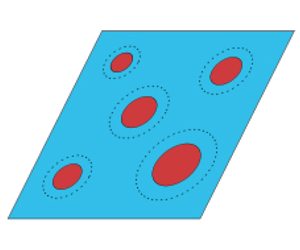Article contents
Theoretical predictions for the rheology of dispersions of highly deformable particles under large amplitude oscillatory shear
Published online by Cambridge University Press: 09 June 2020
Abstract

This work is concerned with the oscillatory rheology of non-colloidal suspensions of highly deformable viscoelastic particles in Newtonian fluids under simple shear loading. To this end, use is made of the homogenization model of Avazmohammadi & Ponte Castañeda (J. Fluid Mech., vol. 763, 2015, pp. 386–432) accounting for the time evolution of the average particle shape and orientation. For small excitation amplitudes, the equations reduce to the small-strain Oldroyd model with expressions for the storage and loss moduli,  $G^{\prime }$ and
$G^{\prime }$ and  $G^{\prime \prime }$, that recover those of Roscoe (J. Fluid Mech., vol. 28 (2), 1967, pp. 273–293) for small particle concentrations. However, at sufficiently large concentrations,
$G^{\prime \prime }$, that recover those of Roscoe (J. Fluid Mech., vol. 28 (2), 1967, pp. 273–293) for small particle concentrations. However, at sufficiently large concentrations,  $G^{\prime }$ and
$G^{\prime }$ and  $G^{\prime \prime }$ may intersect, such that
$G^{\prime \prime }$ may intersect, such that  $G^{\prime }>G^{\prime \prime }$ in a given frequency range. In the large amplitude oscillatory shear (LAOS) regime, the behaviour of
$G^{\prime }>G^{\prime \prime }$ in a given frequency range. In the large amplitude oscillatory shear (LAOS) regime, the behaviour of  $G^{\prime }$ and
$G^{\prime }$ and  $G^{\prime \prime }$ with increasing strain amplitude is consistent with type I or type III behaviour, in the terminology of Hyun et al. (J. Non-Newtonian Fluid Mech., vol. 107 (1–3), 2002, pp. 51–65), depending on the particle properties and concentration. In addition, the rheology is characterized by means of stress waveforms and Lissajous–Bowditch cycles in a Pipkin diagram. By accounting for the microstructure evolution, the model captures a number of nonlinear features commonly observed in the LAOS rheology of complex fluids, including a variety of distorted stress waveforms that manifest themselves in complex intracycle behaviour, as well as secondary loops. Furthermore, as a consequence of directional biases associated with the large deformations of the particles, the model predicts non-vanishing normal stress differences whose characteristic limit cycles are also presented in Pipkin space and reveal the formation of secondary loops for suspensions of Gent particles. However, it should be emphasized that the sources of these nonlinear rheological features for soft particle suspensions are very different from those for rigid particle colloidal systems and, in contrast to the colloidal systems, manifest themselves at dilute volume fractions of the particles.
$G^{\prime \prime }$ with increasing strain amplitude is consistent with type I or type III behaviour, in the terminology of Hyun et al. (J. Non-Newtonian Fluid Mech., vol. 107 (1–3), 2002, pp. 51–65), depending on the particle properties and concentration. In addition, the rheology is characterized by means of stress waveforms and Lissajous–Bowditch cycles in a Pipkin diagram. By accounting for the microstructure evolution, the model captures a number of nonlinear features commonly observed in the LAOS rheology of complex fluids, including a variety of distorted stress waveforms that manifest themselves in complex intracycle behaviour, as well as secondary loops. Furthermore, as a consequence of directional biases associated with the large deformations of the particles, the model predicts non-vanishing normal stress differences whose characteristic limit cycles are also presented in Pipkin space and reveal the formation of secondary loops for suspensions of Gent particles. However, it should be emphasized that the sources of these nonlinear rheological features for soft particle suspensions are very different from those for rigid particle colloidal systems and, in contrast to the colloidal systems, manifest themselves at dilute volume fractions of the particles.
Information
- Type
- JFM Papers
- Information
- Copyright
- © The Author(s), 2020. Published by Cambridge University Press
References
- 7
- Cited by

